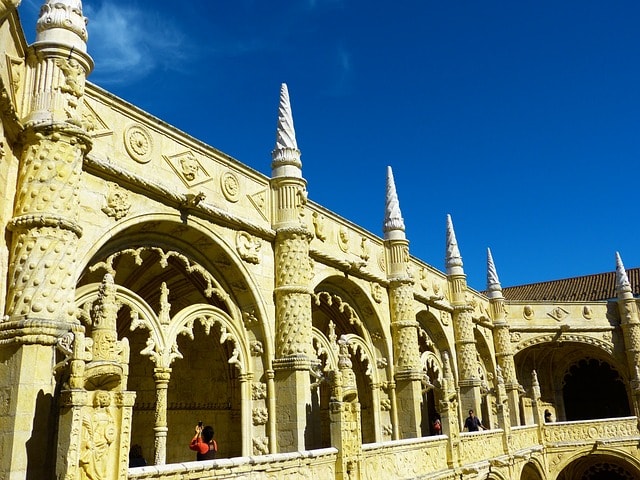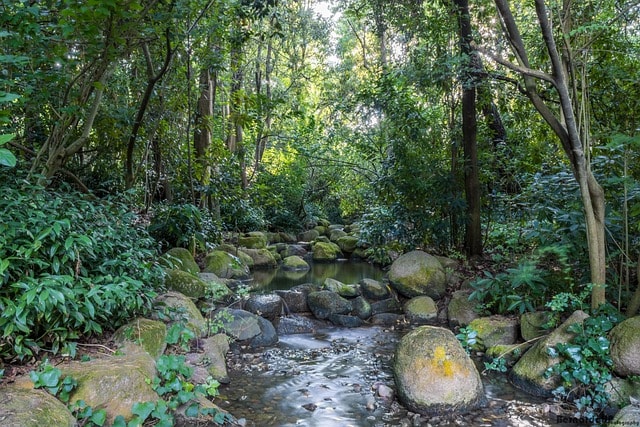Looking for the top attractions in Lisbon, Portugal? You’ve come to the right place. This guide highlights 20 must-see places that capture the essence of this beautiful city, including the most popular attraction in Lisbon, Portugal. Whether it’s history, architecture, or culture, Lisbon has something special for every visitor.
Table of Contents
Key Takeaways
Lisbon’s rich history is exemplified by landmarks like the Jerónimos Monastery and Belém Tower, both showcasing significant architectural styles and cultural contributions.
Cultural institutions such as the Calouste Gulbenkian Museum and MAAT highlight Lisbon’s dedication to art and innovation, offering diverse exhibitions that cater to various interests.
Experiences like Tram 28 and the vibrant Time Out Market provide visitors with unique ways to explore the city’s atmosphere and culinary diversity, making them essential components of a Lisbon visit.
Jerónimos Monastery

Standing as a testament to Portugal’s Age of Discovery, the Jerónimos Monastery is a massive monument that reflects the grandeur of the country’s maritime past. Constructed in the 16th century, this UNESCO World Heritage Site is a stunning example of Manueline architecture, characterized by its intricate designs carved from white limestone. The monastery took over a century to complete, showcasing the dedication of Portuguese royalty to creating this architectural masterpiece.
Jerónimos Monastery is not just an architectural marvel; it also serves as the final resting place for several notable figures, including the famed explorer Vasco da Gama and King Manuel I.
Adding to its cultural significance, the monastery is the birthplace of the renowned Portuguese custard tart, Pastel de Nata, a sweet delight that has become a symbol of Lisbon’s culinary heritage.
Belém Tower

Belém Tower, another gem from the city center, stands proudly along the banks of the River Tagus. Built in the 16th century to protect Lisbon from naval attacks, this fortress later served as a lighthouse and customs center, highlighting its multifaceted role in the city’s defense and navigation. The tower’s Manueline architectural style, designed by Francisco de Arruda, features intricate maritime motifs that are a visual treat for visitors.
Belém Tower stands as one of Lisbon’s most iconic landmarks, making it a must-visit for anyone exploring the Portuguese capital. Climbing the steep, spiraling staircase to the main terrace rewards visitors with breathtaking panoramic views of the river and esplanade, making it a perfect spot to capture the essence of Lisbon’s maritime heritage.
São Jorge Castle

Perched atop the highest hill in Lisbon, São Jorge Castle offers visitors a journey back to the 7th century BC, where they can explore the remnants of a Moorish castle influenced by Visigoths, Moors, and medieval structures. This ancient fortress provides not only a historical glimpse into the past but also offers unparalleled panoramic views of the city and the Tagus River.
The castle has seen significant renovations, especially after suffering damage from major earthquakes in 1531 and 1755, ensuring its preservation for future generations. Today, the castelo de São Jorge is a vibrant venue for various events, including concerts and family celebrations, making it a lively part of Lisbon’s cultural scene.
Calouste Gulbenkian Museum

Housing a vast collection of over six thousand artifacts, the Calouste Gulbenkian Museum is a treasure trove of art and culture spanning from ancient to early 20th-century art. Founded by the Armenian oil magnate Calouste Gulbenkian, this museum is a highlight of Lisbon’s cultural landscape, featuring masterpieces by renowned artists such as Monet, Renoir, and Rembrandt.
Visitors can enjoy the museum’s diverse collection, including the largest set of René Lalique jewelry, showcasing exquisite Art Nouveau craftsmanship. With multilingual audio guides, a café, and an art library, the Calouste Gulbenkian Museum offers an enriching experience for art lovers and casual visitors alike.
MAAT (Museum of Art, Architecture, and Technology)
The MAAT is a striking addition to Lisbon’s array of cultural institutions, focusing on the intersections of modern art, architecture, and technology. The museum’s building itself is a work of art, with its unique curved lines creating a visually stunning silhouette along the riverfront. Inside, visitors can explore a variety of exhibitions that challenge and inspire, making MAAT a must-visit for those interested in contemporary creativity.
The exhibits at MAAT cover a wide range of topics, from cutting-edge technological innovations to modern artistic expressions, ensuring that there’s something to captivate every visitor. This national museum is a testament to Lisbon’s forward-thinking approach to art and culture, similar to other Lisbon museums.
National Pantheon
The National Pantheon, with its distinctive baroque architecture, stands as a monumental tribute to Portugal’s heroes. Its dome, reaching a height of 80 meters, is a marvel of engineering and offers stunning views of the city. The interior of the Pantheon is adorned with intricate stonework and ornamental stones from various regions of Portugal, adding to its grandeur.
Recognized as a national monument since 1910, the National Pantheon houses the tombs of several notable Portuguese figures, including 15th-century explorers and Presidents. Its location opposite the scenic Jardim da Estrela park makes it a serene spot to reflect on the contributions of Portugal’s illustrious past.
Lisbon Cathedral
Lisbon Cathedral, also known as Sé de Lisbon, is the oldest church in the Portuguese capital, with construction beginning in 1147. This Romanesque structure features a Latin cross plan with three naves and a tripartite apse, showcasing the architectural styles of the time. The cathedral’s thick walls and bell towers give it a fortress-like appearance, indicative of its medieval origins.
A Gothic cloister was added during the reign of D. Dinis, making it unique for being placed at the back of the cathedral. The Sé de Lisbon underwent significant reconstruction after the 1755 earthquake, resulting in a Neo-Romanesque appearance that highlights its medieval elements.
Inside, visitors can admire the rose-stained glass window and the fountain where Saint Anthony of Padua was baptized.
Carmo Convent
Constructed in the 14th century, the Carmo Convent exemplifies Gothic and Manueline architectural styles and serves as a poignant reminder of the 1755 earthquake that devastated Lisbon. The ruins of the Carmo Convent now house an archaeological museum where visitors can explore a collection that includes South American mummies, Visigothic pillars, and a Roman tomb.
Open from Monday to Saturday, the Carmo Convent offers a unique glimpse into Lisbon’s past, with admission fees set at €7 for adults and €5 for students. Its location in the downtown district makes it an accessible and educational stop for history enthusiasts.
Basílica da Estrela
The Basílica da Estrela, officially known as the Royal Basilica and Convent of the Most Sacred Heart of Jesus, is a stunning example of baroque and neoclassical architecture. Constructed between 1779 and 1789, this basilica was inspired by St. Peter’s in Rome and the Mafra Palace, reflecting a blend of influences. The interior is adorned with colorful wall tones, a remarkable nativity scene, and decorative elements made of Portuguese marble and paintings by Italian masters.
Visitors can explore the basilica every day from 7.30 am to 8 pm for free, though access to the rooftop costs €5, offering fine views of the city. With its rich architectural and artistic heritage, Basílica da Estrela is a must-visit in Lisbon.
Santa Justa Elevator
The Santa Justa Elevator, an iconic iron structure in downtown Lisbon, was inaugurated by King Carlos in 1901 and officially opened in August 1902. Originally operating on steam power before switching to electric in 1907, this national monument spans a height difference of 45 meters between the Baixa Pombalina and Bairro Alto districts.
Connecting Baixa to Largo do Carmo, the Santa Justa Elevator offers stunning 360-degree views of downtown Lisbon from its viewing platform. As the only remaining urban lift of its kind in Lisbon, it provides a unique vertical connection within the city.
LX Factory
LX Factory, established in 1846, has transformed from an industrial complex into a vibrant cultural hub covering 23,000 square meters. This dynamic space hosts a variety of activities, including markets, exhibitions, and live music performances, making it a lively part of Lisbon’s cultural scene.
With over 50 shops, eateries, and cafes, LX Factory offers a unique dining and shopping experience, allowing visitors to enjoy a meal in settings like a former industrial canteen. Open daily from 9 AM to 7 PM, with free admission, it provides a village-like feel in the heart of the city.
Oceanário de Lisboa
The Oceanário de Lisboa, inaugurated in 1998 during a world exposition focused on ocean conservation, is a leading cultural site in Portugal, attracting around one million visitors annually. The largest indoor aquarium in Europe is located in Parque das Nações. This area is situated in northeast Lisbon.
Visitors to the Oceanário can explore a variety of sea life, including sharks, sting rays, penguins, and otters, within four unique habitats representing different oceans. The facility’s design and thematic exhibits make it a must-visit for anyone interested in marine life and ocean conservation.
Museu Coleção Berardo
The Museu Coleção Berardo, founded by José Berardo in 2006, is a significant contemporary art museum located in the Belém district of Lisbon. Showcasing around 900 pieces from over 500 modern and contemporary artists, the museum features prominent movements like Minimalism, Surrealism, and Pop Art.
Visitors can admire iconic works by artists such as Jean-Michel Basquiat and Cindy Sherman, making it a highlight for art enthusiasts. The museum is closed on Mondays, allowing for visitor planning.
Miradouros (Viewpoints)
Lisbon’s miradouros, or viewpoints, offer some of the most breathtaking views of the city. Miradouro da Senhora do Monte provides panoramic views and holds historical significance as a gathering place for Afonso Henriques. The terrace of the National Pantheon overlooks Alfama and the river, ideal for scenic views.
Other notable viewpoints include Miradouro de Santa Luzia, adorned with bougainvillea and offering beautiful views of the Tagus River and Alfama’s architecture, and Miradouro de São Pedro de Alcântara, featuring a map of azulejos highlighting key city landmarks. These viewpoints are perfect spots to appreciate Lisbon’s beauty from different angles.
Tram 28
Tram 28 is one of the most famous tram routes in Lisbon, offering a nostalgic ride on an antique streetcar through the city’s oldest sectors. The E28 tram connects key neighborhoods including Martim Moniz, Alfama, and Campo Ourique, showcasing the city’s historic charm.
Operating frequently from 6 am to 10:30 pm, Tram 28’s iconic yellow Remodelado trams, dating back to the 1930s, feature original design elements that add to the vintage experience.
Though often crowded, especially between Baixa and Alfama, riding Tram 28 provides a delightful way to explore Lisbon’s narrow streets and cobblestone roads.
Time Out Market
Time Out Market Lisboa is a food lover’s paradise, offering a vibrant dining experience with a range of culinary styles. Reopened in 2014, this bustling food hall features local specialties such as sheep’s cheese, Alentejo ham, and Arcadia chocolates, alongside international cuisine. The market opens daily at 10 a.m., providing ample opportunity for visitors to sample the diverse offerings throughout the day.
A nearby café allows visitors to take a break and soak in the lively atmosphere of the market, making it a perfect spot to recharge before continuing their exploration of Lisbon. With its dynamic mix of food and culture, Time Out Market is a must-visit destination for anyone in the city.
Feira da Ladra
Feira da Ladra, Lisbon’s most famous flea market, operates every Tuesday and Saturday, with Saturdays being particularly popular among tourists.
This sprawling market offers a wide variety of second-hand and antique goods, including:
Vinyl records
Handmade jewelry
Traditional azulejo tiles
Furniture
Shoppers at Feira da Ladra can expect to find unique treasures and engage in the art of bargaining, although significant discounts may not always be available. Located near the National Pantheon, this market provides a vibrant shopping experience where visitors can immerse themselves in Lisbon’s rich culture and history.
Sintra Day Trip
A day trip to Sintra is a magical escape from Lisbon, offering picturesque palaces and villas that have earned it a UNESCO World Heritage Site status. Located approximately an hour northwest of Lisbon, Sintra is easily accessible by train, with a return fare of about €4.80 and a journey time of around 40 minutes.
Sintra is home to some extraordinary attractions, including the Pena Palace, one of Europe’s most remarkable palaces, and the Sintra National Palace, known for its distinctive twin chimneys. Visitors can also explore the Gothic architecture and enchanting gardens of Quinta da Regaleira, as well as the historical Moorish Castle, offering scenic views and a glimpse into the past.
Rua Augusta Arch
The Rua Augusta Arch, located in the heart of downtown Lisbon, is a symbol of the city’s resilience and grandeur. Built to commemorate the reconstruction of the city after the 1755 earthquake, this monumental arch offers unobstructed views of downtown Lisbon and the River Tagus from its top.
Visitors can enjoy a panoramic view of the city, including the cathedral and downtown’s cobbled streets, making it a popular spot for photography and sightseeing. The Rua Augusta Arch is an essential stop for anyone visiting Lisbon looking to capture the essence of Lisbon from above.
Cristo Rei Statue
Inspired by Brazil’s Christ the Redeemer statue, the Cristo Rei statue was erected to express gratitude for sparing Lisbon from the worst horrors of World War II. Opened to the public in 1959, this massive monument stands as a testament to peace and faith.
From the terrace of the Cristo Rei statue, visitors can enjoy panoramic views of the city and the iconic 25 de Abril Bridge. This breathtaking viewpoint provides a serene and reflective experience, making it a must-visit for those exploring Lisbon’s landmarks.
Summary
Lisbon, with its rich tapestry of history, culture, and stunning architecture, offers an endless array of experiences for visitors. From the grandeur of Jerónimos Monastery and Belém Tower to the vibrant markets and picturesque viewpoints, each attraction provides a unique insight into the city’s heritage and charm.
As you explore these top 20 must-see attractions, you’ll discover the many layers that make Lisbon a truly special destination. Whether you’re wandering through ancient cathedrals, enjoying the vibrant atmosphere of Time Out Market, or taking in the panoramic views from São Jorge Castle, Lisbon promises an unforgettable journey. So pack your bags and get ready to immerse yourself in the beauty and history of this lovely Lisbon.
Frequently Asked Questions
What is the best time to visit Lisbon?
The best time to visit Lisbon is during the spring (March to May) or fall (September to October) when the weather is mild and crowds are thinner. This timing enhances the overall experience of the city.
How can I get to Sintra from Lisbon?
You can easily reach Sintra from Lisbon by taking a train from Rossio Station, with a journey time of around 40 minutes and a return fare of approximately €4.80. This convenient option allows for a seamless visit to Sintra’s scenic attractions.
Are there any free admission days for Lisbon museums?
Many museums in Lisbon, such as the Calouste Gulbenkian Museum, provide free admission on Sunday afternoons. This offers a valuable opportunity to explore the city’s rich cultural heritage without cost.
What is the significance of the Jerónimos Monastery?
The Jerónimos Monastery is significant as a UNESCO World Heritage Site that exemplifies Manueline architecture and serves as the burial site for important historical figures such as Vasco da Gama and King Manuel I. Its architectural and cultural heritage underscores its importance in Portuguese history.
What can I expect to find at the Feira da Ladra market?
You can expect to find a diverse selection of second-hand and antique items at Feira da Ladra, such as vinyl records, handmade jewelry, traditional azulejo tiles, and furniture. This market is an ideal destination for unique treasures and collectibles.









